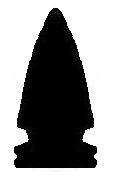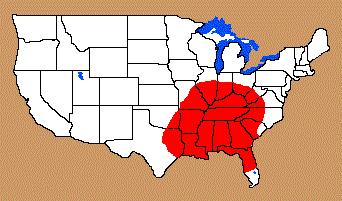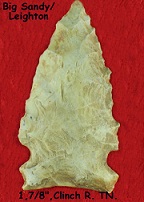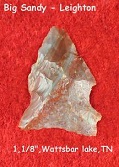Outline is Representative of Size and Shape:

Name Details:
Identified By:
Named For: Big Sandy Variant
Date Identified:
Type Site:
Identified By:
Named For: Big Sandy Variant
Date Identified:
Type Site:
Point Validity:
Collector type
There have been no professional references to this type, but there are many collector source references. This type is considered a collector type.
Leighton Side Notch
AKA: Big Sandy LeightonCluster: Large Side Notch Cluster
Description of Physical Characteristics and Flaking Pattern:
This is a small to medium size triangular point with an elliptical to rhomboid cross section. The blade ranged from excurvate to straight. This point has parallel notches and the shoulders may be horizontal to upward angled. The stem is expanded with a notch on the ears. The base may range from straight to concave. This point has a random flaking pattern.
Size Measurements:
Length - 35 to 50 mm, Stem Length - 10 to 18 mm, Blade Width - 18 to 20 mm, Neck Width - 13 to 20 mm, Stem Width - Approximately the same as the shoulders, Thickness - 6 to 8 mm.
Length - 35 to 50 mm, Stem Length - 10 to 18 mm, Blade Width - 18 to 20 mm, Neck Width - 13 to 20 mm, Stem Width - Approximately the same as the shoulders, Thickness - 6 to 8 mm.
Commonly Utilized Material:
Additional Comments:
Distribution:
Distribution Comments:
These points are most abundant in the Tennessee River valley and has the second highest frequency in the Ohio River Valley. They are less common in the other highlighted areas.
These points are most abundant in the Tennessee River valley and has the second highest frequency in the Ohio River Valley. They are less common in the other highlighted areas.
Age / Periods:
Date: 10,000 - 8,000,B.P.
Cultural Period: Early Archaic
Glacial Period: Early Holocene
Culture:
Date: 10,000 - 8,000,B.P.
Cultural Period: Early Archaic
Glacial Period: Early Holocene
Culture:
Age Details:
This point is part of the Big Sandy Phase.
This point is part of the Big Sandy Phase.
Similar Points:
Leighton, Black Sand, Bolen, Cache River, Ensor, Fairland, Frio, Godar, Graham Cave, Hemphill, Hickory Ridge, Kessell, MacCorkle, Newton Falls, Osceola, Raddatz, Rowan, Savage Cave, St. Charles, Taylor Side Notch
Leighton, Black Sand, Bolen, Cache River, Ensor, Fairland, Frio, Godar, Graham Cave, Hemphill, Hickory Ridge, Kessell, MacCorkle, Newton Falls, Osceola, Raddatz, Rowan, Savage Cave, St. Charles, Taylor Side Notch
Other points in this cluster / Related / Associated Points:
Big Sandy, Big Sandy Broad Base, Big Sandy Constricted Base, Big Sandy E-Notch, Cache River Godar, Graham Cave, Greenbrier, Hemphill, Howard County, Madison Side Notched, Osceola, Osceola Greenbrier, Raddatz, Simonsen
Big Sandy, Big Sandy Broad Base, Big Sandy Constricted Base, Big Sandy E-Notch, Cache River Godar, Graham Cave, Greenbrier, Hemphill, Howard County, Madison Side Notched, Osceola, Osceola Greenbrier, Raddatz, Simonsen



